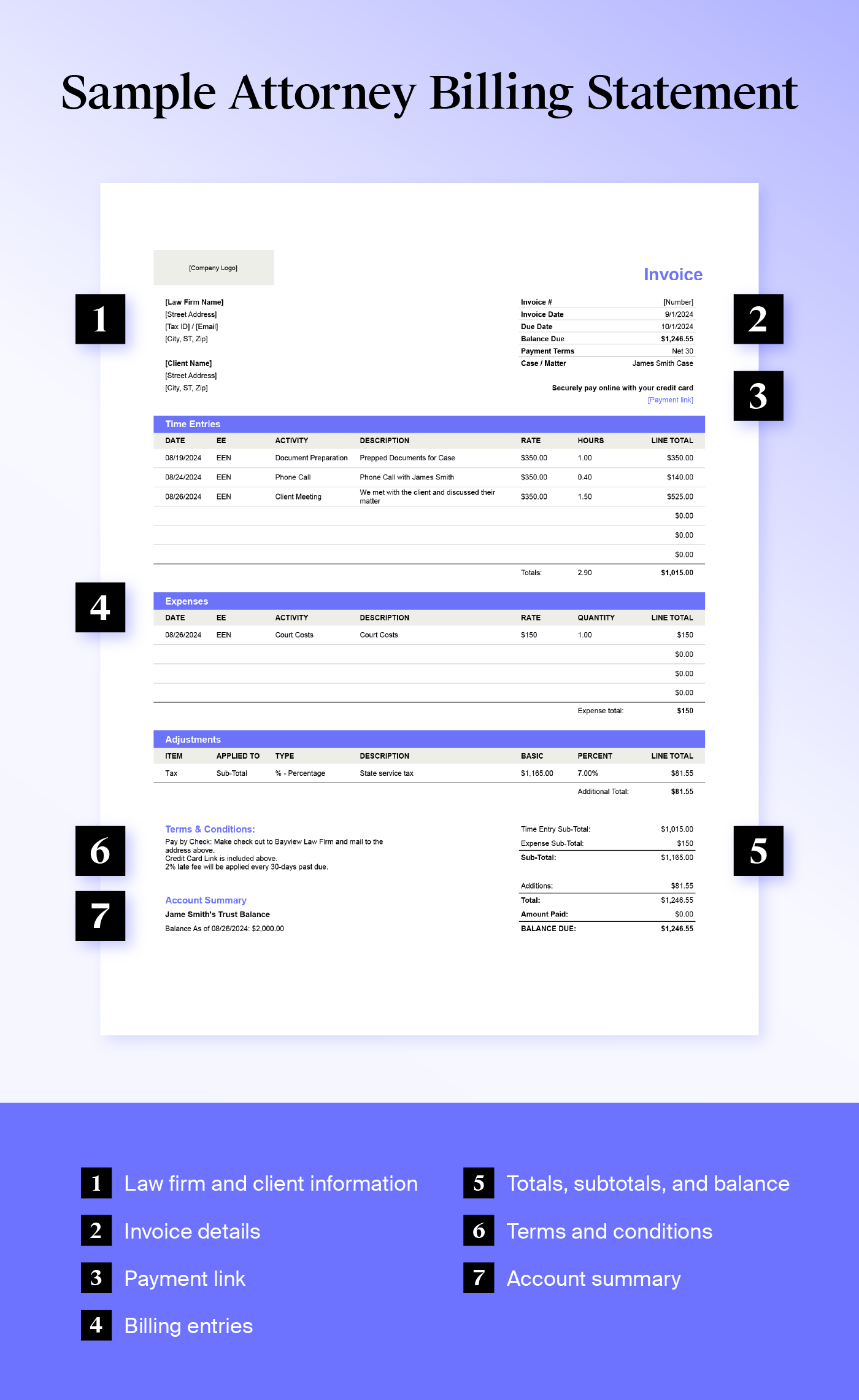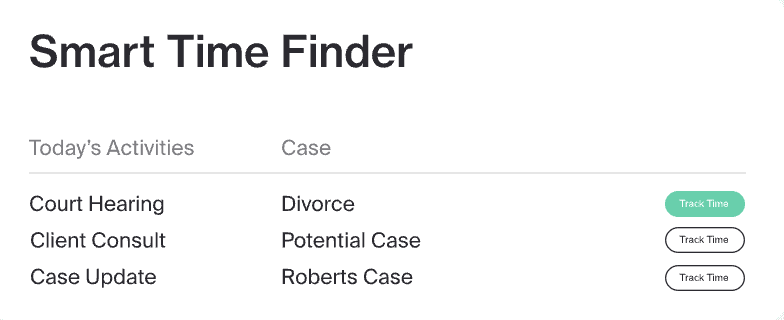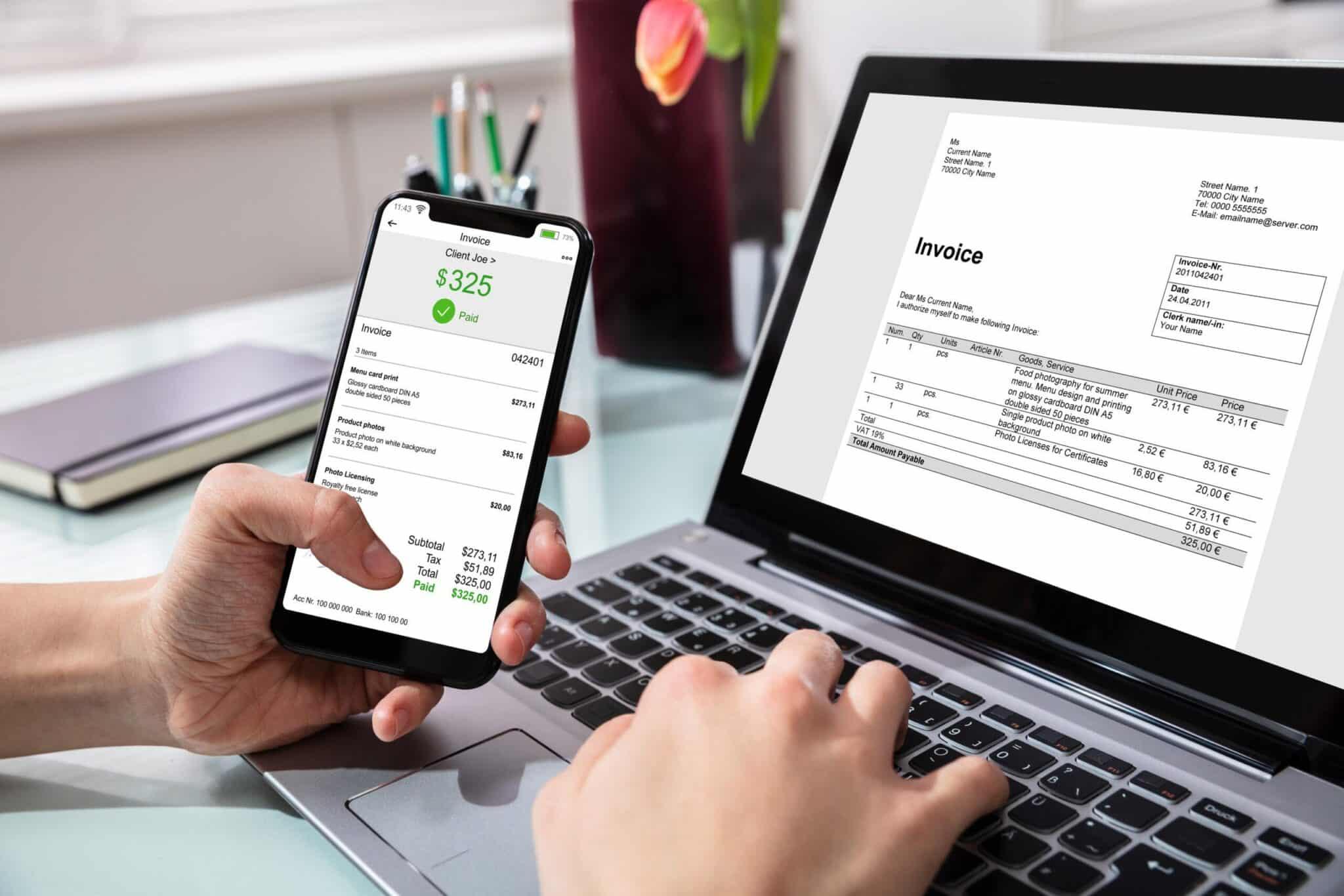If you could change anything about your practice with the snap of your fingers, what would you choose? Many lawyers would pick their time-consuming billing and invoicing processes. After all, most would rather spend time helping clients than completing administrative tasks.
Fortunately, your firm can speed up invoicing using a sample attorney billing statement—a customizable invoice template. In this guide, we’ll cover the following topics.
Steps to creating an attorney billing statement
A sample attorney billing statement
How to establish an efficient pre-billing process that positions your firm for success
Attorney billing best practices that can help improve cash flow
Steps To Creating An Attorney Billing Statement
Creating an attorney billing statement doesn’t have to be a daunting task. Below are simple steps to create a professional and client-friendly invoice:
1. Start with Your Firm and Client Details
Include your law firm’s name, address, phone number, and email, along with the client’s details. Clear identification helps both parties keep accurate records.
2. Add the Invoice Date
An attorney invoice should include the date of issue—the day the invoice goes out to the client.
3. List Itemized Services and Costs
When creating an attorney-itemized billing statement, briefly describe the services provided. For example, your firm may have “prepared documents for a client meeting.” Then, include the amount of time spent on each service. Lawyers billing by the hour typically track time in six-minute increments.
If it took 24 minutes to prepare client documents, for instance, you would log 0.4 hours for that line item. Finally, include the billing rate for each service. This could be an hourly rate or a flat fee.
To save time, you can create sample attorney billing descriptions you can reuse for routine tasks.
4. Include Expenses
Include any applicable expenses on your legal billing template, such as filing costs or court fees. List each expense separately to maintain transparency.
5. Calculate Subtotals, Taxes, and the Total Balance
Once you have itemized services, calculating totals and subtotals should be easy. Many invoicing programs do these calculations automatically.
Calculate the total for each service: Multiply the time spent on each task by the service rate. For example, if you spent 0.4 hours preparing client documents and your hourly rate was $250, the total owed for that service is $100.
Determine the invoice subtotal: Combine the totals for all services to calculate the subtotal.
Add applicable service tax for your state: List the tax rate and the total tax amount in dollars on the billing form.
Calculate the final invoice balance: Add the subtotal and the tax amount to arrive at the total balance owed.
6. Set the Payment Due Date and Late Fee Terms
The statement due date is important, as it tells clients when they need to pay the invoice. You can also list a breakdown of late fees if they don’t fulfill the bill on time. Late fees can be associated with a percentage of the invoice amount or a flat fee per day (up to a cap).
Check with your state bar association before implementing late fees on your attorney billing template. Some state regulations may restrict the amount you can charge every year.
7. Outline Accepted Payment Methods
Let your client know how to pay, such as via check, credit card, or online payment portals. Clear instructions help prevent delays.
You should also discuss payment methods with clients at the start of every matter and include details in your attorney-client agreement. Clients shouldn’t receive this information on the billing form for the first time. This can create an overall negative experience.
8. Include Trust Account Details (if applicable)
An attorney invoice is a great way to update clients about their trust account balance. You can even feature a list of trust account transactions (debits and credits) to keep your team and clients on the same page.
Sample Attorney Billing Statement
Now, let’s combine all of these pieces into one bill template. Below, you'll find a sample statement, along with sample attorney billing descriptions, all created in minutes using MyCase’s legal invoicing software.

With MyCase, your firm can easily generate similar professional invoices in minutes. Customize attorney-itemized billing statement templates to include:
Attorneys and staff assigned to the case
Payment terms and methods
Late fees (with automated application for overdue payments)
How to Prepare for Invoicing and Billing
Crafting a profitable invoicing and law firm billing system starts long before sending a client invoice. Below are a few strategies that can set you up for success.
1. Set Clear Fees
Pricing is at the core of law firm profitability, but it can be tough to know what to charge.
To ensure your fees are competitive and reasonable:
Use tools like the MyCase interactive hourly rate tool to benchmark your fees and find the average hourly rate for lawyers in your area and practice specialty.
Balance profitability with client expectations and the American Bar Association’s guidelines on reasonable fees.

2. Proactively Communicate With Clients
When building positive law firm client relationships, communication is a make-or-break factor. Explain your scope of services and essential invoicing and billing details from the start, so everyone’s on the same page. You’ll also want to touch on the following topics in your attorney-client contracts and the onboarding process.
Fees (broken down by attorney or practice area, if necessary)
Attorney invoice schedules (e.g., monthly or upon reaching certain milestones)
Payment terms, such as how quickly they’ll need to pay
Available payment methods, such as credit cards and ACH
This can ensure that clients don’t receive any unpleasant surprises that negatively impact their experience with your firm. Proactive communication may also help your law firm get paid more often and faster.
Tip: Read our attorney-client interview guide to discover what else you should cover in your consultations, in addition to fees and billing.
3. Track Every Billable Minute
Accurate time tracking is essential for creating precise and transparent invoices. Using a standardized legal time-tracking template can help you get started. However, a comprehensive time-tracking solution can help expedite the process.
With MyCase time-tracking software for attorneys, for example, you can start and stop up to three timers. This feature can help you capture and log all billable hours according to your attorney's billable hours chart as you switch between matters. If you forget to start a timer, our software will alert you to track time when you complete a task, such as sending an email.
Once you’ve logged time with MyCase time-tracking software, instantly convert entries into invoices and easily send out bills. This eliminates redundant administrative work and helps you get bills out on time.

Tip: Use the MyCase Smart Time Finder to identify overlooked actions and quickly create associated time entries. 56% of lawyers who used this feature in 2024 saved measurable time each month, according to the 2025 MyCase Legal Industry Report.
Attorney Billing Best Practices
Using law firm billing and invoicing software to create a customizable bill template can help free up time. To further improve your process and increase collections, try these four attorney billing best practices.
Offer Multiple Payment Options
Accept checks, credit cards, and electronic payments to make it easier for clients to pay. Fortunately, accepting electronic payments doesn’t have to be complicated. LawPay, the industry leader in legal payments, integrates seamlessly with MyCase to streamline your billing and invoicing system.
Consider Payment Plans
Consider offering attorney payment plans, which break fees into installments. This can be more affordable for clients and ensure a more consistent cash flow for your firm.
Use Analytics to Stay Informed
Stay informed about your firm’s finances with MyCase financial analytics. For instance, you can use the “Trust Account” reports to track trust account balances and ensure compliance with state laws. Or, use the “Aging Invoices” report to see all outstanding balances owed to the firm.
With financial data and case analytics, you’ll stay well-informed about your firm’s current and projected finances.
Be Consistent and Clear
In billing, predictability is the name of the game. Send your invoices and reminders regularly, so clients know when to expect them and can budget accordingly. A consistent billing schedule also helps facilitate punctual attorney time-tracking and makes cash flow more predictable.

Attorney Billing Statements Simplified
Creating a legal billing template can be complex and time-consuming, but it doesn’t have to be. Let us handle the heavy lifting so you can focus on growing your practice.
Book a free demo of MyCase today, and find out why more than 14,000 law firms use our legal practice management software to improve efficiency.
About the author

Morgan MartinezSenior Content Manager
Morgan Martinez is a Senior Content Manager for leading legal software companies, including MyCase, Docketwise, and CASEpeer, as well as LawPay, the #1 legal payment processor. She specializes in writing about the latest advancements in legal technology, financial wellness for law firms, key industry trends, and more.
